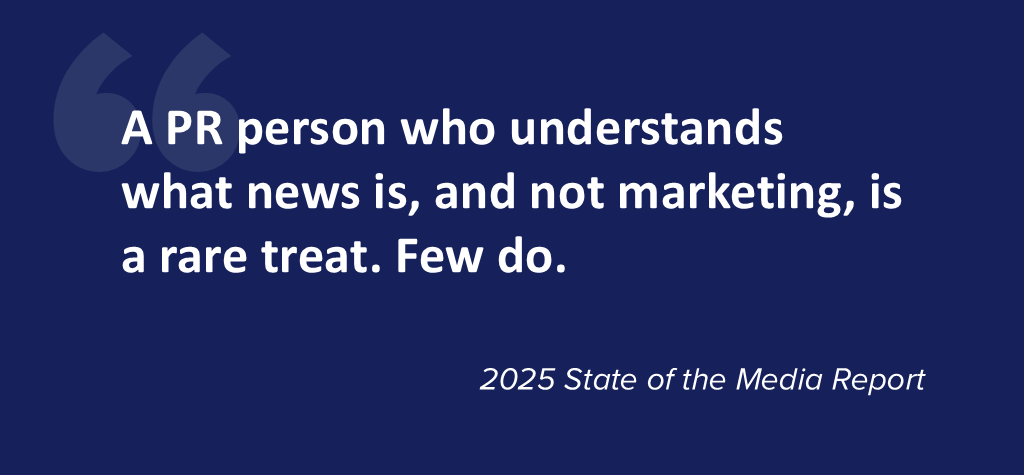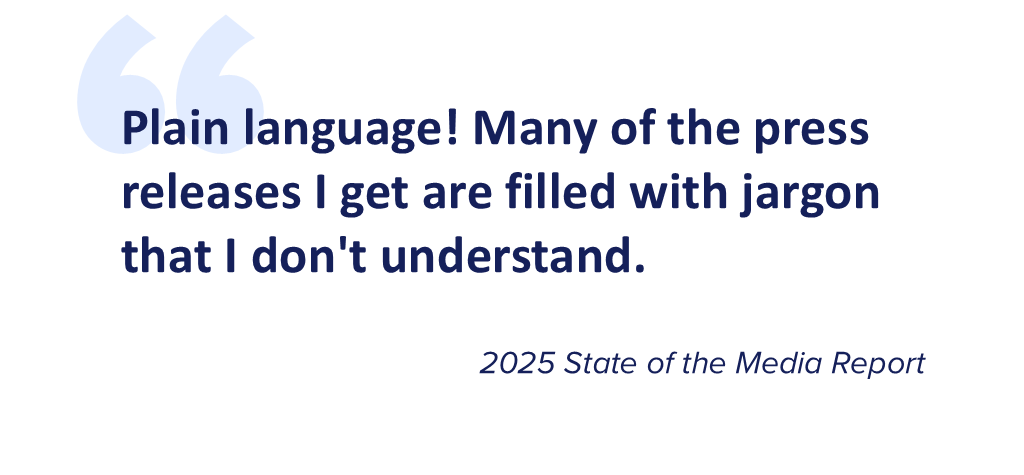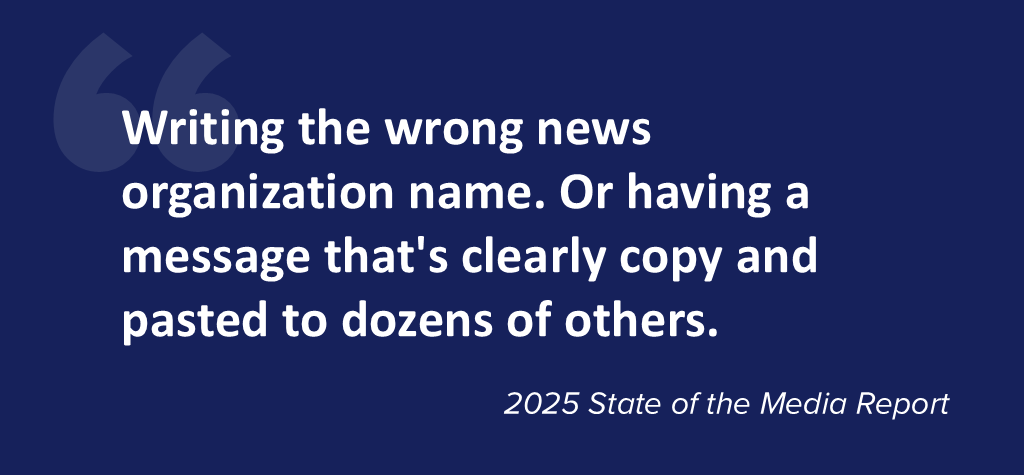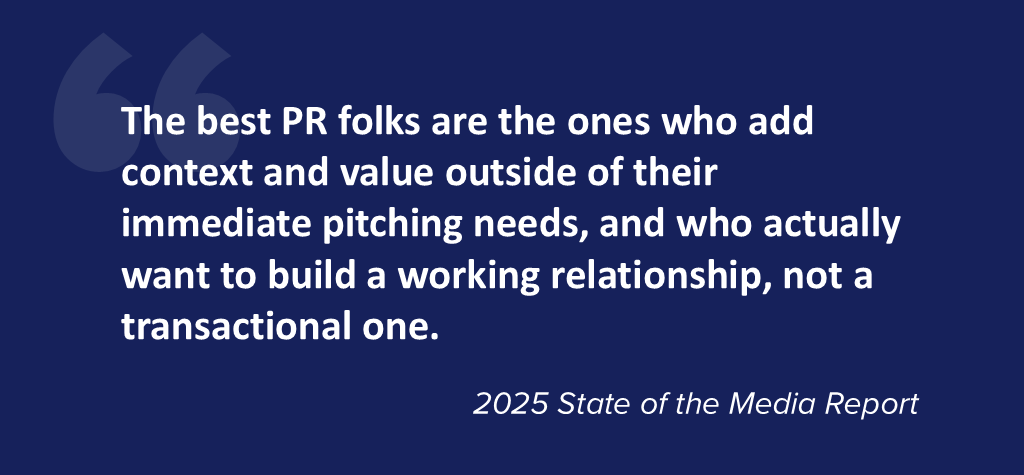Before we get into those five must-know things that can enhance your PR outreach efforts, we need to look at today’s media relations landscape. Currently, there are challenges on both sides: On the one hand, the 2025 Comms Report shows us that 81% of comms leaders feel pressure to “do more with less” – that includes securing more earned media coverage with fewer resources; on the other hand, the most recent State of the Media Report reveals that the No. 1 challenge for journalists is adapting to changing audience behaviors around media consumption – and with half of them receiving over 50 pitches per week, it can quickly become overwhelming to filter through them and decide if they are relevant to their audiences.
So, what can you do as a PR professional to overcome your challenges and meet the high demands of earning more media coverage, knowing that journalists are dealing with (and likely distracted by) their own challenges? Before you turn to PR horoscopes or take out your tarot cards in attempt to understand what journalists are thinking (although that’s something you’re welcome to try out), let’s hear from journalists themselves.
While you could look at the 2025 State of the Media Report (and we highly recommend you do!) for insight into how journalists think, sometimes reading actual words from journalists themselves can have a bigger impact. That’s why we went back into the raw data to pull out even more write-in responses from the journalists who completed our survey. We highlighted some of the hardest-hitting quotes that speak to the realities journalists want you to know about, so you can improve your PR outreach and your relationships with them. While each of these quotes is personal to the individual journalist, we picked out the ones that represented common threads and were consistent with the larger themes and trends of the report.
Meet Inbox Expectations
When journalists open an email from a PR pro, they’re more likely to be impressed if you send them a news announcement or a press release, an exclusive story, or original research reports. But before you send any type of content, make sure it’s relevant to their audience, consider local or regional relevance, and research the journalist’s beat. Here’s what some of them said around this topic:

“I desperately want PR firms to stop contacting LOCAL news stations and offering interviews that have no local connection. If the expert is local, that is amazing. Don't bother pitching a national-level report with an expert from across the country and no local connection.”
“I don't want content. I want actual news/developments that my audience could use. Not PRs pushing influencers. Not marketing garbage about people, events, products, businesses that are irrelevant to my audience.”
“A PR person who understands what news is, and not marketing, is a rare treat. Few do.”
“[We want] anything that we couldn't get ourselves as journalists (anything that we can find ourselves becomes useless, as the PR person isn't offering any actual product).”
“I want PR professionals to make sure they know my beat before emailing me.”
“Regarding trends – I do not need information on silly ideas like the most popular Halloween costume or what people eat during the Super Bowl. Real news trends, yes, but please don't fill my inbox with stupid stuff.”
A Pitch on Its Own Won't Do
No matter how well-written and relevant your pitch, it isn’t a guarantee it’ll get noticed and secure you earned media coverage. When we asked journalists what the ‘ideal’ pitch includes, these were the top three answers: Try to include compelling data or statistics, a unique story angle or point of view, and your contact information. In their own words, here’s what journalists think makes an ideal pitch:

“Having someone immediately available at the time the release is sent out. Sometimes you call on a press release, and they don't want to provide an on-camera interview, which defeats the purpose of sending a press release (for TV).”
“The opportunity to experience the story myself and put my own angle on it as a content creator.”
“Plain language! Many of the press releases I get are filled with jargon that I don't understand.”
“It's really helpful if there's a photo of the pitch spokesperson or of the company's headquarters building, if the pitch is coming from and promoting a specific company.”
“Links to schedule directly (Calendly or similar) to avoid going back and forth with a PR person who is also going back and forth with the other party.”
“Please don't say 'happy to send more if interested...'. Just send it so I can see if it works. And embargoes don't help anyone, if anything they make it harder for freelancers since we can't tell who else is covering it till it comes out.”
Be Mindful of Boundaries
In any relationship, there are certain triggers that can affect it beyond repair. According to our survey, most journalists won’t hesitate to put you on their “don’t call” list if you spam them with irrelevant pitches or if you send pitches that sound like marketing brochures. Trust can easily be broken if you provide inaccurate or unsourced information, especially as our findings indicated that a top challenge for journalists is maintaining credibility as a trusted news source. Here are a few examples of PR faux pas to avoid:

“They pull a 'bait and switch' by offering a strong interview and later downgrade it to someone we don't want to talk to.”
“Following up with me through multiple channels within a few hours (i.e. email, LinkedIn, a phone call and a text within three hours).”
“Failing to arrange an interview they have pitched [or the] source turns out not to be knowledgeable on the subject.”
“Writing the wrong news organization name. Or having a message that's clearly copy and pasted to dozens of others.”
“When their pitch is clearly too biased in favor of the client at the expense of believability.”
“Faceless content that is very clearly not my areas of work but make them look like they are doing something to make their clients happy.”
“I have never blocked any PR people.”
Build a Genuine Connection
Most journalists are open to building relationships with PR pros – but the right approach makes all the difference. When asked about the best way to initiate a connection, most journalists agreed that the best way is a surprisingly simple one: Introduce yourself over email and tell them why you want to connect. Of course, everyone has their own preferences, so we wanted to dive deeper into other ways you can make a good first impression. Some of the most telling responses include:

- “Know at least a little about me and the kinds of things I'm interested in, rather than just pitch me wildly on everything.”
“Too many PRs forget what the 'R' in PR stands for. Reach out and make contact. You are far more likely to engage with a press release from someone you have met in the past.”
“Treat meeting me like building a source relationship. If you provide me with useful information and treat me respectfully, I will do the same.”
“Offer to add me to their distribution list with a quick sidenote explaining who they are/what they do.”
“Be involved in the community. PR people are usually from out of town and wouldn't know anybody on sight.”
“I think PRs focus too much on building relationships, whereas journalists actually just want their time saved by relevant pitches.”
Give Them Something More
You’re more likely to build a strong relationship with a journalist if you provide value – in a sea of PR pros who want their stories covered, you’ll stand out if you connect them with relevant sources, facilitate access to key people or places, and provide story ideas (these were the top three answers they gave when asked about the ways in which PR pros provide value). Here’s how some other journalists articulated they appreciate most about PR professionals:

“The best PR folks are the ones who add context and value outside of their immediate pitching needs, and who actually want to build a working relationship, not a transactional one.”
“They often have greater resources than reporters and when they're compassionate and principled – this can help create better coverage more quickly.”
“Unique story angles are key. I'm not interested in ‘content’. If the story isn't interesting to the PR professional, it won't be interesting to my readers, either.”
“As a freelancer, they offer access before pitching to newspapers and magazines – so vital they approach freelancers early.”
“They manage the relationship with the source.”
“We rarely use PR outlets as sources for our stories as we produce local news content.”
The Bottom Line
If there’s one key takeaway from these responses, it’s that building trust with journalists can be done by simply listening – understand their challenges, be mindful of their busy schedules, keep your promises, and give them valuable resources.
For even more insight into the journalist mindset, download the 2025 State of the Media Report, and register for our upcoming webinar for live, first-hand perspectives from real-life journalists.
Most Recent Posts
Cision Resources
-
E-books and Guides
Comprehensive how-to guides on strategy and tactics
-
Case Studies
What are other brands doing – and how can we learn from them?
About Bianca Parvu
Bianca is the Junior Copywriter at Cision, specializing in tech industry storytelling. She crafts engaging content across digital channels, from thought leadership to email marketing campaigns.
Learn More. Do More. demo new
PR Tips, Case Studies, and Product Updates

[On-Demand Webinar] The Next Generation of Media Intelligence: From Gorkana to CisionOne
Explore CisionOne, a revolutionary media intelligence platform, and the evolution of Gorkana. Learn key features and strategies from Luke Williams, CisionOne Product Marketing Manager. Elevate your media outreach to new heights!


